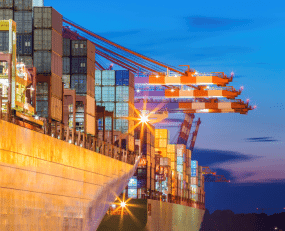
Two leading container shipping lines reported figures at the second quarter and half-year point over the past week, confirming the general trend towards solid profits in the face of weak volumes.
Maersk saw Earnings Before Interest, Depreciation and Amortisation (EBITDA) jump by 25% year-on-year over the second quarter. This was despite revenue falling by 6.5% and seeing volumes down by 15%.
The key to Maersk’s success was what it called “agile capacity deployment” in its core container shipping business. However, other parts of the group were also fairly stable with Logistics, in particular, experiencing markedly higher profits despite demand being fairly flat. This may be due to a better performance in air freight forwarding. The Terminals business was also more profitable in the face of soft demand.
The picture at Hong Kong based Orient Overseas (International) Limited or ‘OOIL’, owner of OOCL shipping line, was slightly different with H1 revenue edging up by 3.9% year-on-year but operating profits falling by over 20% to $155m. Container volumes fell just 3%. Overall revenue per TEU increased over the period with the Asia-Europe route being particularly buoyant. Like Maersk, OOIL says that it managed by “paying careful attention to customer demand and reviewing and calibrating our services accordingly on a timely basis” and “prioritised cost management during the anticipated tough conditions of 2020”.
The fact the robustness of the container shipping sector is no longer a surprise is quite remarkable. At one time it might have been expected that sustained falls of this magnitude would have led to the severest distress in this market. It also would have led to large falls in prices. Yet this is no longer the case. Whilst this might seem to be good news for both investors and those in the shipping sector, it may not be such quite good news for those buying container shipping services. OOIL comment that they have ordered five new 25,000 TEU vessels, something that in the past would have assumed to have implications for the balance between demand and supply and thus freight rates. In the present structure of the container shipping industry however, it may not wise to make such assumptions.
Source: Transport Intelligence, August 25, 2020
Author: Thomas Cullen